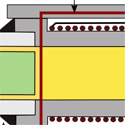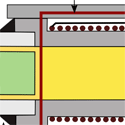A probe for supersolidity—or the lack thereof
In 2004, a group at Pennsylvania State University attributed the apparent loss of rotational inertia in a helium- crystal to the coexistence of crystalline and superfluid phases. Since then, researchers have excitedly sought evidence that this interpretation is correct—or looked for an alternative explanation. Scrutiny has already suggested that extended structural imperfections and lighter-isotope (helium- ) impurities play a crucial role. Writing in Physical Review Letters, Sung Su Kim of the University of Florida’s National High Magnetic Field Laboratory and colleagues show that nuclear magnetic resonance (NMR), a tool that can probe the microscopic dynamics of the host helium lattice, could be helpful in resolving the controversy.
Kim et al. measured the spin relaxation rates of helium- impurities embedded in the helium- crystal as the crystal was cooled through the purported supersolid transition temperature. The NMR signal from the impurities is sensitive to the quantum tunneling of single or weakly paired atoms of helium- , which in turn is sensitive to the dynamics of the host lattice.
The spin-lattice relaxation rate peaks at about the same temperature as the reported rotational anomalies, a finding that could support the possibility of a transition into a supersolid phase. More extensive measurements are needed to explore the alternative that a collective, yet noncritical, change in lattice dynamics is occurring instead. Kim et al.’s results also join the list of known anomalies that any microscopic model describing helium- must endeavor to explain. – Yonko Millev





